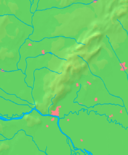Yeregin
| Svätý Jur | ||
| Sankt Georgen, Szentgyörgy | ||
| Town | ||
|
||
| Country | Slovakia | |
|---|---|---|
| Region | Bratislava | |
| District | Pezinok | |
| Tourism region | Bratislava a okolie | |
| Elevation | 180 m (591 ft) | |
| Coordinates | 48°15′07″N 17°12′56″E / 48.25194°N 17.21556°ECoordinates: 48°15′07″N 17°12′56″E / 48.25194°N 17.21556°E | |
| Area | 39.874 km2 (15.395 sq mi) | |
| Population | 5,523 (2015-12-31) | |
| Density | 139/km2 (360/sq mi) | |
| First mentioned | 1209 | |
| Mayor | Šimon Gabura | |
| Timezone | CET (UTC+1) | |
| - summer (DST) | CEST (UTC+2) | |
| Postal code | 900 21 | |
| Area code | +421-2 | |
| Car plate | PK | |
| Statistics: MOŠ/MIS | ||
| Website: www.svatyjur.sk | ||
Svätý Jur (German: Sankt Georgen, Hungarian: Szentgyörgy) is a small town northeast of Bratislava, the capital of Slovakia. The name means Saint George, and the town's coat of arms shows the saint killing the dragon. Between 1960 and 1990, the Communist government forced the town to use a "non-religious" name Jur pri Bratislave. Svätý Jur has a population of 5,523 citizens.
Svätý Jur is situated in the Pezinok District of the Bratislava Region in southwestern Slovakia. The surrounding areas include large vineyards in the nearby Little Carpathians and the unique Šúr swamps, a protected area.
Archaeological excavations date the original settlement to the Hallstatt period and the Quadi period.
In the 9th century, a Great Moravian castle was built here. Svätý Jur was first mentioned in a written source in 1209 and received a town charter in 1299. It became a royal free town in the Kingdom of Hungary in 1647.
Defensive city walls were constructed between 1603 and 1664, but Svätý Jur was devastated by the Ottoman Turks in their invasion of 1663. The Ottoman troops also destroyed the White Castle (Slovak: Biely Kameň), which had been an important administrative center of the region until then.
In the 18th century, the Hungarian government recruited German farmers to repopulate the area. To encourage migration, it allowed the Germans to keep their language and religion in order to develop farmland for cultivation and produce. Through the 19th century and into the 20th century, the population of this area was largely ethnic German, although by that time they spoke an archaic form of German. They were known as Danube Swabians. In part because Nazi Germany used the eastern ethnic German communities as an excuse for its wars of expansion in eastern Europe, after World War II, ethnic Germans were forcefully expelled to Germany and other Western countries.
...
Wikipedia






